Florida Trees and Shrubs
On this page - Geiger Tree, Groundsel tree, Firebush, Coco Plum, Deerberry, Fetterbush, Staggerbush, Buttonbush, Brazilian Pepper Tree, Lantana
Native
Geiger Tree - Cordia sebestena
Family - Boraginaceae
_small.jpg)
_small.jpg)
Habitat - Coastal strand, Coastal hammocks in southern most Florida counties
Description - The Geiger tree is widely considered to be a Florida native tree although it is more likely an introduced species. Slow growing to a height of 25 feet with an equal spread the Geiger tree has large, alternately arranged rough textured dark green leaves with undulate margins. Attractive orange flowers are produced the year round and are profuse in the spring and summer.
Groundsel tree - Baccharis halimifolia
Family - Asteraceae
Native
_small.jpg)


Habitat - Margins of fresh and salt marshes, wet woodland forests
Description - Very common native Florida shrub or small tree to about 14 feet, taller than broad usually with many branches. Leaves are alternate, pale green with rough upper surfaces and margins with a few coarse teeth toward the tips, somewhat obovate to lanceolate in form. Some leaves with entire margins. Flower is stalked, white to greenish-white, produced on numerous heads in early fall.
Firebush - Hamelia patens
Family - Rubiaceae
Native
%20_small.jpg)
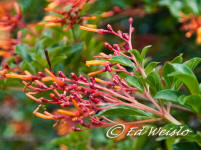
Habitat - Open areas in woodlands, margins of hammocks, coastal strand.
Description - Native Florida evergreen shrub or small tree with multiple trunks to 10 feet or more in height. Leaves are elliptic with entire margins, leaf margins and veins often tinged red, usually opposite, sometimes arranged in whorls. Widely used in home, commercial and municipal landscapes. Attractive to butterflies and birds. The tubular red and orange flowers are produced year-round.
Coco Plum - Chrysobalanus icaco
Family - Chrysobalanaceae
Native

_small.jpg)

Habitat - Coastal swamps, coastal scrub, bay swamps, cypress domes.
Description - Native shrub or small tree up to 15 feet in height. Leaves are 2 -3 inches, evergreen, simple, alternate, broadly elliptical to nearly round with smooth entire margins on short petioles.
Flowers white, (may be pink tinged) 1/4 inch borne on short irregularly branched clusters near ends of branches. Fruit is 1 to 2 inches in diameter, dark purple to nearly black at maturity and has a waxy appearance.
Deerberry - Vaccinium stamineum
Family - Ericaceae
Native

Habitat - Pinelands, Hammocks
Description - Native to Florida, grows as an evergreen shrub or a small tree, 10-15 feet tall with an equal spread. Leaves are alternate, simple, elliptic to obovate with entire margins, 1-3 inches long, commonly increasing in size toward tips of branches.
Flower - White, campanulate, (bell shaped) from leaf axils on long stalks, with the numerous yellow stamens extending past the corolla. Fruit a berry, whitish blue to deep purple when mature.
Shiny Lyonia, Fetterbush - Lyonia lucida
Family - Ericaceae
Native
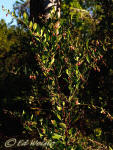
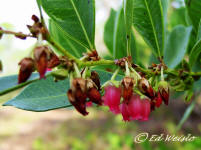
Habitat - Found throughout Florida, prefers moist sites; Wet Flatwoods, margins of ponds, swamps and marshes.
Description - A sprawling evergreen shrub with long arching stems, averaging three to five feet tall, sometimes taller. Suckers from roots, forming dense thickets, making it difficult to traverse, hence the name Fetterbush. Leaves are broadly elliptic to almost lanceolate, shiny, dark green and 1-3 inches long, leaf margins are entire with a prominent vein that runs parallel with margins.
In spring, pale to deep pink urn shaped flowers are produced in clusters from leaf axils on previous seasons growth.
Rusty Lyonia, Staggerbush - Lyonia ferruginea
Family - Ericaceae ( Heath family )
Native
_small1.jpg)
Habitat - Pine Flatwoods, Scrub
Description - Native shrub or small tree. Commonly 3 to 12 feet high, occasionally may grow to 20 feet or more. Typically grows with many crooked or contorted stems that have reddish brown, scaly, ridged bark. All parts of this plant are covered with a rusty brown pubescence, particularly new growth and underside of the 2-4 inch oblanceolate leaves.
Flower - Fragrant, white, urn or bell shaped in axillary clusters in spring, fruit is a five-sided ovoid brown capsule 1/4 inch long.
Buttonbush - Cephalanthus occidentalis
Family - Rubiaceae
Native
_small.jpg)
%20detail_small.jpg)
Habitat - Banks of streams, lakes, Swamps and wetlands.
Description - Native perennial shrub to 12 feet, sometimes more with an equal spread. Leaf green, whorled, margin entire, ovate with pinnate veins, 4 - 8 inches.
Flower - White, fragrant in 1 1/2 inch, round, tightly packed clusters.
Brazilian Pepper Tree - Schinus terebinthifolius
Family - Anacardiaceae
Exotic / Invasive
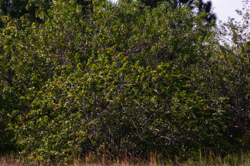
%20flower_small.jpg)
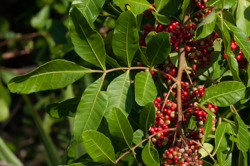
Description - Perennial shrub or small tree up to 40 feet in height, forms dense thickets of tangled branches and stems. Originally introduced to Florida as an ornamental plant in the 1800's, the Brazilian Pepper has become a major pest. Flowering in the fall (Sept.-Nov.) the fruit is a small red berry that is eaten and dispersed by birds.
An aggressive invader of many habitats, the Brazilian pepper tree is estimated to occupy over 700,000 acres in central and southern Florida. Leaves have a "peppery" smell when crushed. Sap is a irritant similar to that of Poison Ivy to which it is related. Smoke from burning wood is also toxic.
Lantana, Shrub Verbena - Lantana camara
Family - Verbenaceae (Verbena family)
Exotic / Invasive

Perennial, Deciduous. Shrub/Vine. Height up to and over 6 feet with multiple square stems. Similar in appearance to the endemic native Lantana species (Lantana depressa Small), the native has tapered or crenate leaf bases whereas the exotic species has a squared off or truncate leaf base.
Leaves are aromatic when bruised or crushed, small flowers are held in dense flat topped clusters and may be white, pink, lavender, yellow, orange to red in a single cluster, changing color over time.
Fruit is a small green round drupe, turning purple and then blue-black. Long touted as a low maintenance landscape plant, now widespread in various habitats where it has interbred with native lantana species.